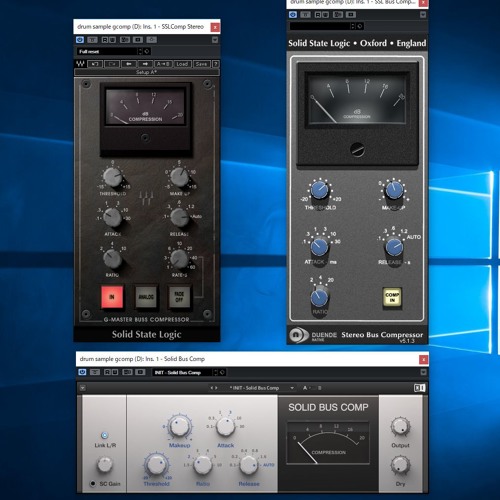

"I normally don't really endorse anything," comments Lord-Alge, "but when the Waves bundle came out, I knew that SSL had given them the green light to officially copy the E-series EQ.
WAVES SSL 4000 SERIES BUS COMPRESSOR VS PRO
Last year Chris Lord-Alge, hitherto not perceived as the world's most enthusiastic Pro Tools and plug-in user, surprised many by endorsing Waves's new SSL 4000 bundle, even offering the company his SSL settings for a variety of instruments, so they could use them as plug-in presets. If I ever wanted to change, I would like them to make me a new one from scratch, with the same technology." I've had my desk modified, with line amps and buss amps brought up to G+ spec, but it still sounds like an E-series.

It's like plugging a nice Les Paul into a Marshall stack or a great tube amp. I'm not saying that the 'J' and the 'K' and the Duality are bad, but I appreciate the character of the E-series. "I look at the E-series as SSL's 8078: it's the classic SSL with the classic SSL sound.

But what the computer does, it does well, and in the mixes I have done over the years, I've never needed more than fader and mute automation. Sure, the G-series had a bigger keyboard, but for automation you don't really need to be able to type letters to anybody! I prefer it simple with a small keyboard and a computer that you probably couldn't even run a modern video game on. It is comfortable to use and it sounds musical. The recall, the compressor and gate, the way the channel strip is laid out, the ease of automation with a very simple computer that just does faders and mutes. "I have camped in front of an E-series SSL since it came out in 1985, and I don't think SSL have since improved on the concept of that console. Lord-Alge elaborates on these ageing tools of his trade and why mixing 'in the box' is still irrelevant for him. Much of Lord-Alge's gear appears to date from 15 years ago or more, and it's a sign of how fast technology is moving that one feels compelled to explain that the 3348 is a 48-track digital two-inch tape machine that was first introduced in 1989, and Lord-Alge has the original 16-bit/48kHz version. In addition to the fact that his mix room is unusually airy and spacious for a recording studio, there are three other things that immediately attract attention: his 60-input 4056 E-series SSL, the incredible amount of mostly vintage outboard gear present, and his Sony 3348. Vintage & ModernĬhris Lord-Alge, whose younger brother Tom is a very successful mixer in his own right, works from Resonate Studios in Burbank, Los Angeles. The list of those who have benefited from the Chris Lord-Alge mix treatment is inordinately long, but to name just a few: U2, Snow Patrol, Sheryl Crow, Dave Matthews Band, Savage Garden, Green Day, Placebo, Alanis Morissette, Bon Jovi, Faith Hill, Melissa Etheridge, the Futureheads, Fleetwood Mac, Pink, Foo Fighters, Black Eyed Peas, Courtney Love, Heather Nova and Santana. But since the late 1990s he's focused exclusively on mixing. In Lord-Alge's early days his activities also included engineering, keyboards, programming and producing. Lord-Alge moved to Los Angeles in 1988, and in subsequent years he added names such as Prince, Tina Turner, Stevie Nicks, Joe Cocker and Peter Frampton to his résumé. This was followed by a stint as staff engineer at Unique Recording in New York. The first are from his early days as an assistant engineer at H&L Studios in New Jersey. The triple Grammy-winning mixer has become a genuine legend of the studio industry, to the extent that needs eight pages to list his 750-plus credits. Enter Chris Lord-Alge.Ĭhris Lord-Alge has an uncanny knack for making rock tracks both hard-hitting and hit-parade-friendly. With its 150+ tracks encompassing everything from a marching band to a children's choir, it took a special talent to craft a hard-hitting, radio-friendly mix from My Chemical Romance's 'Welcome To The Black Parade'.


 0 kommentar(er)
0 kommentar(er)
